- News & information
- About
- History
- George V. Voinovich
- George V. Voinovich Collection
- Calendar
- How to Find Us
- News
- Archives
- Photojournalism Fellowship Project
- Photo Essays
- Current Fellow
- Previous Fellows
- Reports and Publications
- Archives
- Students
- Prospective
- Center for Entrepreneurship
- Environmental Studies
- HTC/Voinovich School Scholars
- Master of Public Administration
- Current
- HTC/Voinovich School Scholars
- Center for Entrepreneurship
- Environmental Studies
- Master of Public Administration
- Alumni
- Contact
- School Leadership
- Strategic Partners Alliance
- Ohio University Public Affairs Advisory Committee
- Ohio University Public Affairs Advisory Committee
- Faculty and Fellows
- Faculty
- Visiting Professors
- Voinovich Fellows
- Professional Staff

Light: a quantum particle

 Light Sources
Light Sources
 Light Sources
Light Sources
All hot objects emit light.
Examples:
- Car in the sun --> `heat waves" = infrared (IR)
- Burnger on a stove --> infrared and red light
- Light bulb filament --> all visible light
- sun --> infrared and visible and ultraviolet (UV)
 Black Body Radiation
Black Body Radiation
A body that absorbs all radiation that falls on it is called black body
.  Black Body Radiation
Black Body Radiation
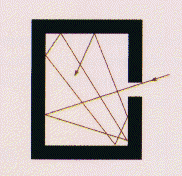 Cavity with a small entrance hole
Cavity with a small entrance hole
Energy entering a small hole in a chamber rattles around until it is
absorbed. In reverse, the aperture in a heated enclosure appears as
a blackbody source.
When a black body is heated , it starts to glow and a characteristic black body spectrumis emitted.
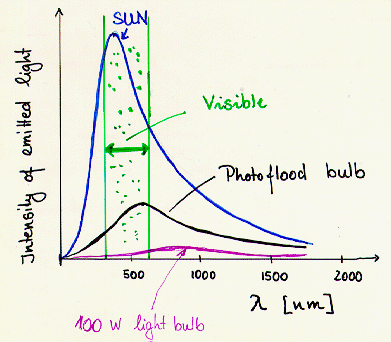
A black body spectrum has the following properties:
- More energyis emitted from hot objects than from cool ones.
- The peak emission occurs at higher frequencies for hot objects and at lower frequencies for cooler objects.
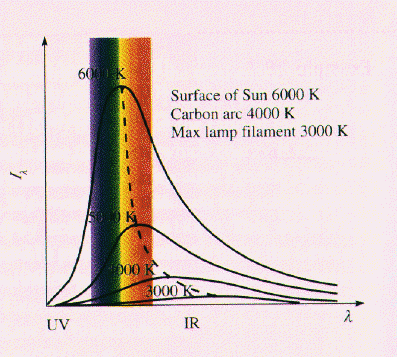 The amount of radiant
energy emitted by a hot object at various wavelengths. Each curve peaks
at a point whereT = constant, which is the Wien Displacement Law
.
The amount of radiant
energy emitted by a hot object at various wavelengths. Each curve peaks
at a point whereT = constant, which is the Wien Displacement Law
.
A hot filament and the spectra it emits. As the temperature rises form (a) to (c), the corresponding emission curves shift, as shown in the figure above. The peaks of the curves moe toward the yellow, and the bue and of the spectrum increases in intensity as well. The result is that the color of the filament shifts from cherry red to white hot.
Try it! Blackbody Radiation
 Incandescent Light
Incandescent Light
 Incandescent Light
Incandescent Light
is created by the glow of hot objects.
Incandescent electric light
consists of hot, glowing filaments
(tungsten filament).
 Light as Particle
Light as Particle
 Light as Particle
Light as Particle
| Important Terms related to Atoms | |
|---|---|
| Element | A chemical substance that cannot be broken down further |
| Atom | The smallest particle that retains its chemical identity |
| Molcule | Any collection of two or more atoms bound together |
| Electron | An atomic particle with negative charge and small mass |
| Nucleus | The small, massive central part of an atom |
| Proton | Positively charged nuclear particle |
| Neutron | Electrically neutral nuclear particle |
| Ion | An electrically charged atom |
 The Bohr Atom
The Bohr Atom
The idea is that the electron can exist at a distance r 1 from the nucleus, or at a distance r 2 from the nucleus, or at a distance r 3 from the nucleus and so on. As long as the electron remains at one of those distances, its energy is fixed. The electron cannot ever, at any time, be in orbit any place between these allowed distances.
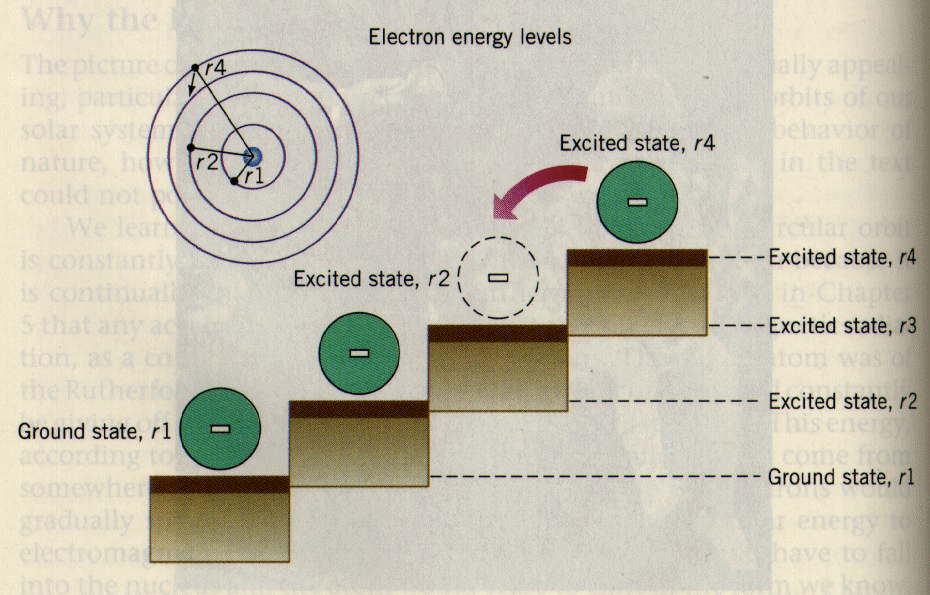
An electron in an atom can be in any of a number of allowed orbits, and each allowed orbit is at a different energy. One can see this by noting that one would have to exert a force over a distance to move one electron from one allowed orbit to another, just as muscles have to exert a force to kick up a ball a flight of stairs. The allowed energy levels of an atom occur as a series of steps. The electron in the lowest level is called the ground state , while all energy levels above the ground state are called excited states .
In (a) the electron of a hydrogen atom is in its ground state.
Assume that an electron is in an excited state as shown in (c) . The electron can move to the lowest state, but if it does, something must happen to the extra energy. The energy that is left over when the electrically charged electron moves from an upper state to a lower state is emitted by the atom in form of a single packet of electromagnetic radiation, a particle-like unit called a photon . Every time an electron jumps from a higher to a lower level, a photon moves away at the speed of light. In this sense, light behaves like a particle, though it behaves at the same time as a wave.
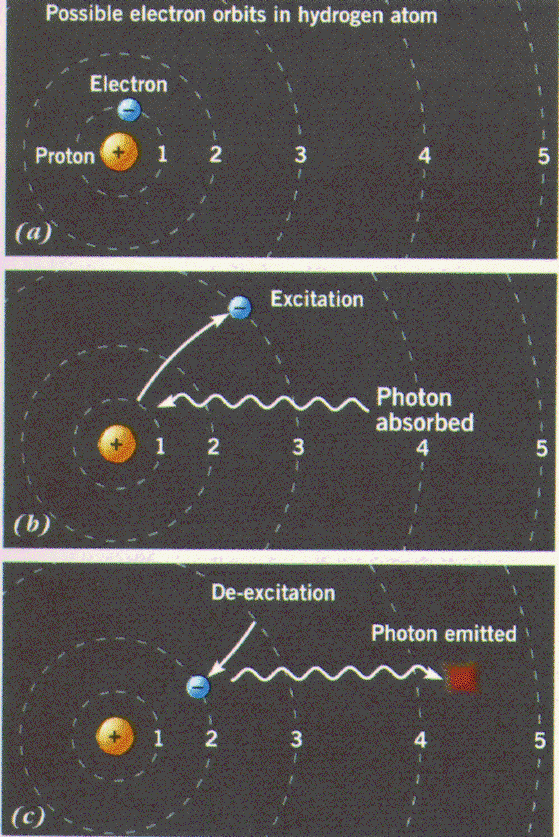
Electrons may jump between the energy levels shown in (a) and in the process absorb (b) or emit (c) energy in form of a photon. This process is called a quantum leap or quantum jump and is fundamental in nature at the atomic scale.
 Sequence of events in (b)
:
Sequence of events in (b)
:
- electron in ground state level
- atom absorbs a photon
- electon jumps to an excited energy level
 Sequence of events in (c)
:
Sequence of events in (c)
:
- electron in excited energy level
- transition to lower energy level
- emission of photons
- photon : quantum of light with a distinct frequency
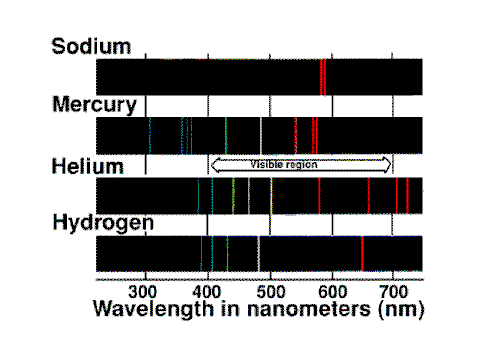
The processes leading to spefic emission lines are shown here:
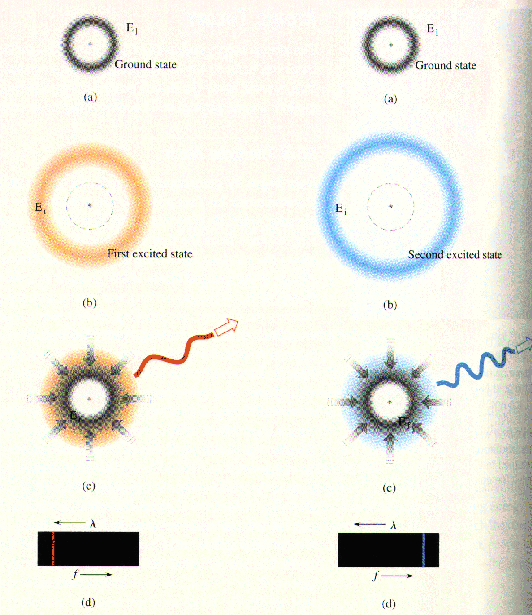
The left panel shows that an atom in the first excited state drops back to the ground state with the emission of a long-wavelength, low energy photon. The emission shows up as a long-wavelength, low-frequency spectral line.
The right panel shows an atom in the second excited state that drops back to the ground state with the emission of a short-wavelength, high energy photon.
Absorption and Emission of Radiation by an Atom

Aug 26 14:27:03 EDT 2019
Contact Information:
(740) 593–9381 | Building 21, The Ridges
Ohio University Contact Information:
Ohio University | Athens OH 45701 | 740.593.1000 ADA Compliance | © 2018 Ohio University . All rights reserved.
